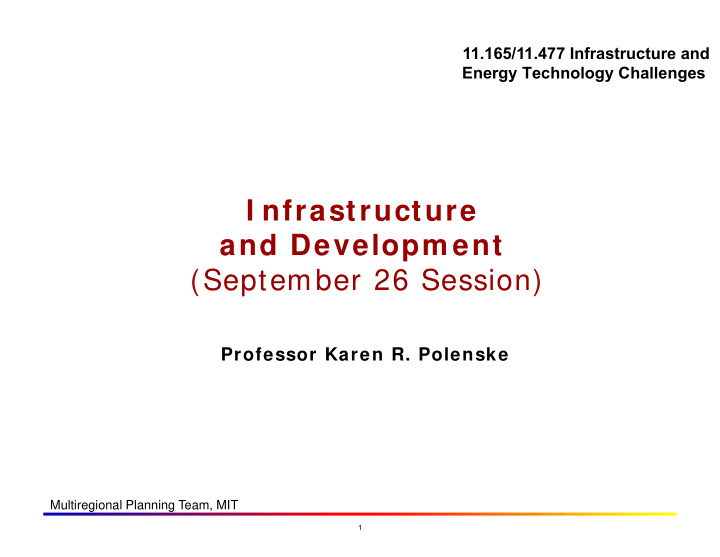



11.165/11.477 Infrastructure and Energy Technology Challenges I nfrastructure and Developm ent (September 26 Session) Professor Karen R. Polenske Multiregional Planning Team, MIT 1
RECENT NEWS President Barack Obama stood in front of an aging bridge on the turf of the top Republicans on Capitol Hill and called for passage of his $447 billion package in tax cuts, jobless aid and public works projects. Headline from the Washington Post (Sept. 22 2011): Tolls will soon double on some Maryland highways as officials approved a statewide increase Thursday to confront deteriorating and congested roads and bridges, and a lack of money to pay for improvements. Multiregional Planning Team, MIT 2
MAJOR EVENTS/PROJECTS The Louisiana Purchase— 1803 augmented the land area of USA by 828,000 square miles—doubling its size and paying only $27 million. The Erie Canal-- New York state—October 26, 1825 inaugural journey by Governor DeWitt Clinton. They found limestone that hardened under water to line sides of canal. Multiregional Planning Team, MIT 3
MAJOR EVENTS/PROJECTS The Transcontinental Railroad— Initial 36 miles in the West cost the CP (Central Pacific) railroad $3 million. By the end of 1865, 7,000 Chinese were building the line. The Union Pacific railroad was built in the East. On May 10, 1869, the two met at the summit of the Promontory Mountains in Utah. The railroads were granted large tracks of land and mineral rights. •The Land Grant Colleges—1862 Justin Morrill wanted to create a network of government-funded colleges in each state. What university do you know that is a land- grant university? Multiregional Planning Team, MIT 4
MAJOR EVENTS/PROJECTS The Homestead Act—1852 passage of Andrew Johnson’s act. 300 million acres settled by homesteaders between 1862 and 1955. It represented the largest transfer of public land to private individuals. The Rural Electrification Administration— 1936 5 million farms were without electrification The Interstate Highway System— 1919—it took 62 days to cross the USA by car 1956 bill signed by President Eisenhower to create the Interstate Highway System Multiregional Planning Team, MIT 5
6 DISCUSSION QUESTIONS •Conceptually, what is the mechanism through which infrastructure investment contributes to economic development and/or poverty reduction? •How do the three articles explain the mechanisms differently? (i.e., what effect does investment in rural infrastructure have? What about investment in urban infrastructure?) Multiregional Planning Team, MIT
7 DISCUSSION QUESTIONS • In reality, why is it difficult to measure the contribution of infrastructure to development? • Whom does the infrastructure serve? How do different financial and institutional arrangements change the benefits and costs of infrastructure? Compare the following pairs: Tolls v.s. no tolls Private sector v.s. public sector Taxes v.s. tolls • What types of policies can make infrastructure services more accessible to the poor? M ultiregional Planning Team, MIT
MIT OpenCourseWare http://ocw.mit.edu 11.165 / 11.477 Infrastructure and Energy Technology Challenges Fall 2011 For information about citing these materials or our Terms of Use, visit: http://ocw.mit.edu/terms.
Recommend
More recommend